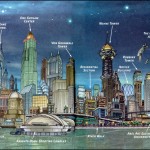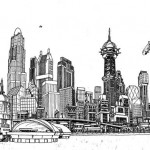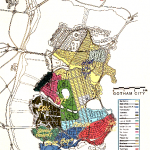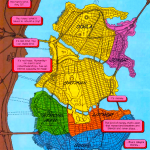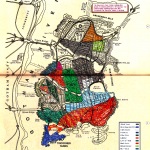
The Gotham earthquake was the worst on its kind in recorded East Coast history. It measured 7.6 on the richter scale and was centered in the Spillkin Hill area of Bristol Township about 10 to 20 miles north of the city center. Worse still, mosts buildings in Gotham had not been properly prepared for the possibility of such quakes, since nothing similar had ever been experienced on the East Coast. The only ones left standing were those owned by Wayne Enterprises and the Wayne Foundation, thanks apparently to what had seemed like an eccentric decision by Bruce Wayne and CEO Lucius Fox.
By the time the death toll of the Gotham earthquake had reached one million, the city had already been written off in the hearts and minds of many U.S. citizens. As roads and rail lines connecting Gotham to the rest of the United States were slowly reopened to traffic, the collapse of Gotham picked up even more steam as its citizens evacuated en masse. Soon after, a combination of an executive order and Congressional statute effectively rendered Gotham legally nonexistent. It forced the evacuation of almost all remaining citizens from the Core Islands. It also ordered the permanent confinement of those Gotham residents with criminal records, as well as the destruction of all known bridges and tunnels linking Gotham with the mainland by the U.S. Army. Anyone who remained –whether by federal order, choice of conscience, or simple lack of the means to leave– was stripped of their United States citizenship. The river was mined; the airspace patrolled by plane and helicopter. Anyone trying to get in or out of the Gotham islands risked a summary death sentence.
As Bruce Wayne, Batman had left the city to try and solve the problem politically, using his name and money to convince the federal government to belay closing off Gotham. Unfortunately, his efforts failed, arguably because he appeared to the government as Bruce Wayne–an air-headed millionaire with little concern for serious issues–of which the No Man’s Land was exemplary.
The Supreme Court subsequently aggravated the atrocity by narrowly approving the No Man’s Land Declaration as constitutional. The vote was five to four, the majority upholding the Declaration despite the obvious case for nullifying it on the grounds that it violated several Constitutional amendments. Reversing the decision would take the better part of a year. Some one-hundred days after the Federal Declaration of the No Man’s Land, Bruce returned to Gotham to reclaim the Batman title and his people, many of whom had long since given up on him. Even his former partner, Jim Gordon, believed that Batman had abandoned Gotham to the Arkham escapees. The city had been transformed into an almost medieval feudal state.
The next year saw a constant, a life-or-death struggle for the future of Gotham and for the citizens left behind. With edicts condign convicts, former convicts, and the inmates of Arkham Asylum to the Gotham islands, the rest of the remaining inhabitants were reduced to reinvented feudalism of a sort that echoed the worst days of Beirut and Sarajevo. “Lords of the Sectors” ruled the new Gotham – urban warlords whose sovereign territory was measured in square blocks and who would be informally crowned, throned, and dethroned with alarming and savage regularity.
Not all these warlords were evil, though. Among them was James Gordon. Gordon had chosen to remain behind to make sure that some sort of order, if not law, would return and prevail until the Declaration was rescinded. Many members of the Gotham City Police Department stayed as well. Much of what is known about the events of No Man’s Land is due to the records kept by Oracle, who, without the benefit of advanced technology, used her resources to become a low-tech version of herself. She used paper to document events and the passage of time, operatives and emergency phones (knowing which ones were still in operation) to gather intel, and colored maps (see above images) to keep track of who controlled which portions of the city at a particular time.
Her maps were frequently shown in the comics to help the reader follow the progression of territorial disputes. In fact, so crucial were these maps to the storyline that DC Comics created the definitive map of Gotham City for No Man’s land. This map was even used to create the Gotham of Christopher Nolan’s Batman films.
Meanwhile, in the world outside Gotham, the backlash against the No Man’s Lad Declaration was already underway. Lobbying by corporate interest groups and human rights organizations, spearheaded by Wayne Enterprises and the Wayne Foundation, slowly but steadily reached a fever pitch over the next 10 months. The tide finally became irreversible by Day 312 because of two factors. The first factor was Timothy Drake. The teenage son of local industrialist Jack Drake recently returned to the Gotham Heights area of Bristol; Timothy had reportedly taken a dare from classmates and somehow beat all obstacles to break into the Gotham islands with no more than the clothes on his back and a cell phone. When Timothy let his father know what he’d done, it set off political dynamite all the way to Washington.
The U.S. Marshals Service rescue mission into the city to retrieve young Timothy was the least of the reaction to the far that there were still children living inside the “No Man’s Land.” The second factor was Lex Luthor’s entrance into the anti-No Man’s Land camps. He publicly defied the White House and Congress, damning the No Man’s Land Declaration as an immoral law that he refused to obey. Luthor personally flew into Gotham’s Grant Park on Day 312 to set up “Camp Lex” as his headquarters for the restoration efforts. He dared Washington to either arrest him or rescind the No Man’s Land Declaration. Unbeknownst to anyone at the time, Luthor’s plan was to secretly gain ownership of the entire city.
Luthor’s plan was foiled after Batman recovered original documents from Gotham’s archives that proved Lex Luthor committed fraud in his attempted acquisition. Luthor left Gotham after the discovery. On Day 332 the White House finally bowed to the pressure now coming from all sides as a result of the Drake rescue and Luthor’s challenge. It conditionally rescinded the No Man’s Land Declaration. Gotham City would be restored to the United States of America on New Year’s Day, provided basic services could be restored to at least one-quarter of the Gotham islands by that date.
Answering the call were LexCorp, S.T.A.R. Labs, Wayne Enterprises, the Wayne Foundation, and three brigades of the United States Army Corps of Engineers, among many others. The challenge given by the White House was not only met, but exceeded. On New Years’s Day, Gotham City rejoined the United States of America. From then on, the rebuilding of Gotham began in earnest. Known as the “Billion Dollar Buildup”, it was the biggest Federal Works Project since before World War II. 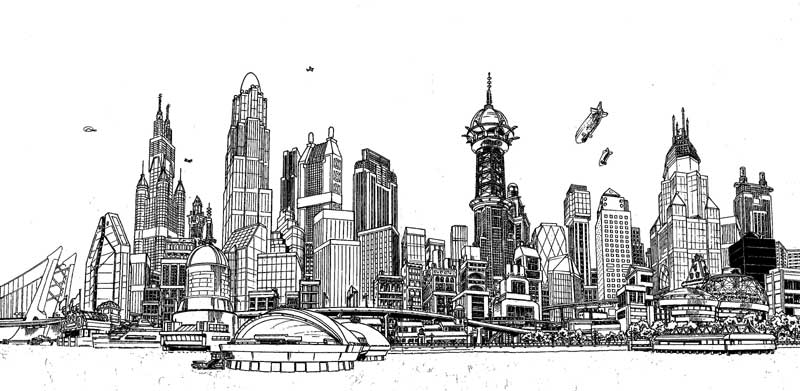 Those who returned to Gotham after the days of No Man’s Land were a more resilient, resourceful, and cynical populace. The built a more dramatic and varied architecture, with an influx of new locals adding to the rebuilding of the city. The Gotham envisioned during the reconstruction scarcely resembled the Cyrus Pinkney-influenced towers of old Gotham. While still distinctly recognizable as Gotham, the new skyline was brighter by night than what was ever previously envisioned by Solomon Wayne, who would likely not recognize this new city but who, if his last words are to be believed, would likely approve of the new city.
Those who returned to Gotham after the days of No Man’s Land were a more resilient, resourceful, and cynical populace. The built a more dramatic and varied architecture, with an influx of new locals adding to the rebuilding of the city. The Gotham envisioned during the reconstruction scarcely resembled the Cyrus Pinkney-influenced towers of old Gotham. While still distinctly recognizable as Gotham, the new skyline was brighter by night than what was ever previously envisioned by Solomon Wayne, who would likely not recognize this new city but who, if his last words are to be believed, would likely approve of the new city.
[This history of No Man’s Land is largely excerpted from The Daily Planet Guide to Gotham and batman.wikia.com.]
No Man’s Land has inspired many Batman stories in film and television. If you haven’t read this canonical text, I can’t recommend it enough. Jump right in to the action with the No Man’s Land Volume 1 paperback or savor the build-up with Cataclysm!
